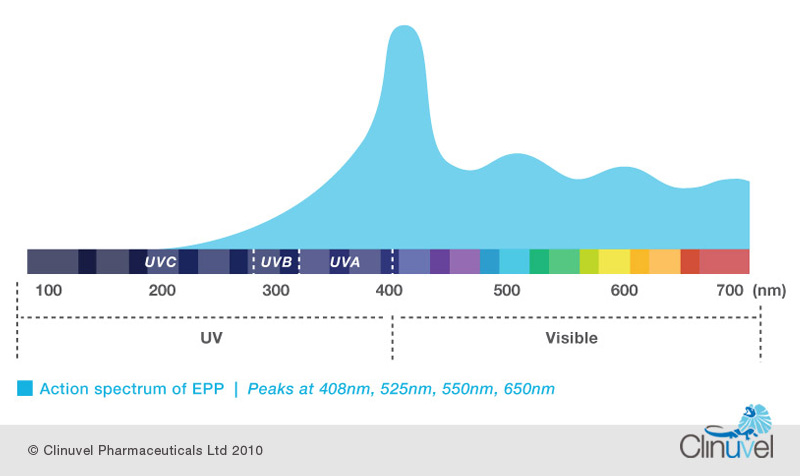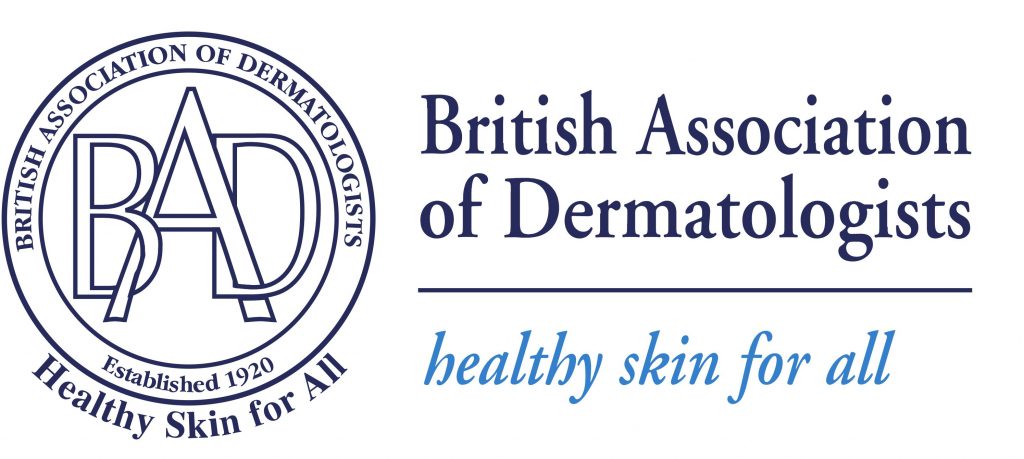Skin safety
Skin safety and protection is vital for those with skin porphyrias. The cutaneous (skin) porphyrias, as well as variegate porphyria and hereditary coproporphyria, can all cause skin problems. All cause reactions to sunlight on exposed areas of skin. As with all porphyrias, the severity of the problem varies enormously, as does the type of symptom experienced. Read more on the porphyrias page.
Exposure of the skin to sunlight should be avoided as much as possible. When avoiding sunlight is not possible, mineral sunblocks that block visible light can help. Hats and clothing which cover up the skin are also recommended.
Sunscreens
The skin/cutaneous porphyrias are characterised by reactions to visible light. Therefore conventional sunscreens formulated to protect against just ultraviolet (particularly UVB) are ineffective. For all skin porphyrias, reflectant sunscreens that are based on titanium dioxide or zinc oxide will be more effective. This is because they cover both UVA, UVB, and visible light to a degree. In the UK, the SPF (sun protection factor) number tells you how effective the sunscreen is for UVB. The star rating (usually found on the back of the bottle, with a maximum 4 stars) gives a measure of the UVA protection.
An example of a reflectant sun screen is the Dundee Reflectant Sunscreen. Dundee Cream is different to a normal sunscreen, as it is a large-particle-size reflectant sunscreen.
DUNDEE CREAM UPDATE SUMMER 2024: there are supply issues with Dundee Cream caused by a lack of access to a key ingredient. Production has stopped and patients are unable to access the sunscreen. We are working to find other options for patients but in the meantime, there are some other sunscreens available which may provide some relief.
Mineral sunscreens containing zinc oxide and/or titanium dioxide offer some level of protection by providing a physical block to visible light. Generally, the larger the particle size, the greater the protection. So the creams that offer the greatest protection are likely to be thicker, messier and quite opaque (like Dundee Cream).
Some alternatives available are shown below – the top two have been shown to be at least as effective as Dundee Cream and in some colours, even more so (see article reference below, Eadie, et al).
- Anthelios Mineral One (light, medium, tan, brown and dark brown), La Roche-Posay
- Anthelios Pigment Correct, La Roche-Posay
- Surf Mud natural zinc
- Invisible Zinc Broad Spectrum 50 SPF
- Neutrogena Sheer Zinc-Oxide Face dry-touch sunscreen 50 SPF
- Cyacelle 50+ UVA/UVB/HEV large spectrum
protection
Article reference: Ewan Eadie, Martin Josso, Rita Touti, Pascale Renoux, Robert S Dawe, Sally H Ibbotson, Commercial visible-light protecting sunscreens for photosensitive individuals, British Journal of Dermatology, Volume 188, Issue 3, March 2023, Pages 445–447, https://doi.org/10.1093/bjd/ljac112
Though these sunscreens will not offer full protection, they may provide a little marginal gain.
We will continue to work towards improving the accessibility of a sunscreen (on prescription) and will keep you updated.
Clothing
A few key items of light-protective clothing can offer very helpful protection for the skin, especially in the summer months. Wide brimmed hats, long sleeves, gloves, base layers and umbrellas are all useful tools. Some tips to bear in mind:
- Close-knit/tight weave fabrics in dark colours offer greater protection for visible wavelength problems. The lighter (in colour as well as weight) clothing materials that can be very helpful for people with severe UV problems, will not always be very helpful in EPP. Because the problem is due to visible rays in the porphyrias, the human eye can be used as a meter: if the clothing is held up and stretched and not much sunlight or indoor light gets through it should provide reasonable cover.
- Base layer clothing and base layer type stuff designed for water sports such as rash vests are very flexible. They can go under t-shirts without looking too out of place and as they are designed to take hot air away from the skin, and can be worn without overheating too much. Decathlon does some good stuff to try at a reasonable price https://www.decathlon.co.uk/C-815236-rash-vests-and-sun-protection-clothing.
- Long-sleeved tops and long trousers cover the greatest area of skin.
- Gloves are useful especially when driving.
- A buff can help to protect the vulnerable neck area.
- Shoes rather than sandals can protect the feet.
- Wide-brimmed hats can help
- An umbrella can enable longer periods outdoors. Useful UV reflective umbrellas can be purchased from www.umbrellaheaven.com.
UV protective clothing which you may wish to try can be found on websites such as www.equatorsun.com and www.coolibar.com. Many more high street companies are stocking UV protective clothing now at a reasonable cost. Try www.decathlon.co.uk or www.mountainwarehouse.com for some good options.


Window films
The light that protoporphyrin absorbs is different from that which causes ordinary sunburn. Usually sunburn is caused by the shorter wavelengths of ultraviolet light (UVB), but in EPP the skin is more sensitive to longer ultraviolet wavelengths (UVA) and to visible light, EPP pain is due to violet light at 400-420nm.
Some EPP sufferers have found that using film on car (and home) windows is useful to give them a bit more time exposed to sunlight before pain occurs. With regards to car windows the rules on cars from DVLA are:
“75% of visible light has to be able to come through front and back windows and 70% through the front side windows”. Therefore for cars there is a compromise between letting visible light through and stopping the violet light which causes the pain in EPP and still having a legal car. There are no restrictions on rear passenger windows or the rear windscreen
Our medical colleagues recommend the following filter films for cars or home: ARC UVCL (ARC Window Films) or Dermagard give about 50% protection to EPP patients and are legal on cars and completely clear and colourless. They block out everything up to 400nm, nothing past 420nm and since EPP pain is due to 400-420nm they therefore give 50% protection from the pain-inducing waveband.
However, amber films give almost 100% protection for EPP patients. Amber films are suitable for almost any window. The only windows amber film cannot be installed to, are the driver and passenger windows of a car, as only clear films may be installed to these windows under DVLA Regulations.
A few companies that supply the above types of films can be contacted as below:
- Bonwyke Ltd, Unit 3 Salterns Lane Industrial Estate, Salterns Lane, Fareham, Hampshire, PO16 0SU Tel: 01329 289621 Fax: 01329 822768 Email: sales@bonwyke.co.uk www.bonwyke.co.uk
- ARC Window Films, Unit D, Stratus Business Centre, Coupland Road, Hindley Green, Wigan, WN2 4HX, Tel: 01942 523 078. sales@arcwf.com, www.arcwindowfilms.com
- Durable Ltd, Unit 1, 498 Reading Road, Winnersh, Reading, Berkshire, RG41 5EX, Telephone: 0118 989 5200, info@durable.co.uk, http://durable.co.uk/



